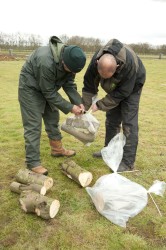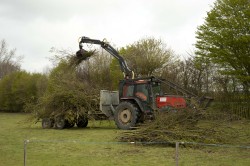Summary
Summary

This project aims to provide a better understanding of the risks posed by Asian longhorn beetle in the UK. The detailed information obtained by the project will also help to improve future surveys and monitoring.
Research objectives
The objectives of the current analysis are to:
- determine which species of tree were most at risk from ALB and in which parts of the tree the pest was most likely to be found;
- establish whether ALB has a 1-, 2- or 3-year life-cycle in southern England;
- assess how long the infestation at Paddock Wood had been present and how quickly the pest was spreading.
Results so far
 The most important host species at Paddock Wood was sycamore, Acer pseudoplatanus. Twenty-six per cent of all A. pseudoplatanus growing within the outbreak area were attacked by ALB and this species contained 70 and 98 per cent of the total larvae and adult exit holes, respectively. In comparison, only 3 per cent of field maple (Acer campestre), poplars (Populus spp.), willow (Salix spp.) and birch ( Betula pendula) were attacked. ALB larvae and pupae were found in branches with a diameter as small as 2.1 cm, but most occurred in stems and branches 4–10 cm in diameter.
The most important host species at Paddock Wood was sycamore, Acer pseudoplatanus. Twenty-six per cent of all A. pseudoplatanus growing within the outbreak area were attacked by ALB and this species contained 70 and 98 per cent of the total larvae and adult exit holes, respectively. In comparison, only 3 per cent of field maple (Acer campestre), poplars (Populus spp.), willow (Salix spp.) and birch ( Betula pendula) were attacked. ALB larvae and pupae were found in branches with a diameter as small as 2.1 cm, but most occurred in stems and branches 4–10 cm in diameter.
Status
Research on the ALB outbreak started in March 2012 and the analysis of the life-cycle and outbreak history are ongoing.
Related Services
To report a finding of Asian Longhorn Beetle to Forest Research scientists use TreeAlert.
If possible, the beetle should be caught and placed in a secure container such as a glass jar so that a Plant Health inspector can collect it.
Related Resources
Recent publication:
Host plant selection and resource utilisation by Asian longhorn beetle Anoplophora glabripennis (Coleoptera: Cerambycidae) in southern England, by N.A. Straw, N.J. Fielding, C. Tilbury, D.T. Williams & D. Inward (2015) Forestry 88, 84–95.
Asian Longhorn Beetle Pest Alert
Background
Asian longhorn beetle (ALB) is native to China and the Korean peninsula, and poses a serious threat to a wide range of broadleaved trees. The main pathway for entry into the UK is wood packaging material that has not been treated and individual specimens of Asian longhorn beetle have been found in the UK on a number of occasions.
In March 2012 a breeding population of ALB was confirmed by Forest Research scientists in the Paddock Wood area near Maidstone in Kent. A joint operation by the Forestry Commission, Forest Research, the Food and Environment Research Agency (Fera) and Defra appears to have been successful in eradicating the outbreak.
Funders and partners
This research is funded by the Forestry Commission under the Programme Advice and Scientific Support for Tree Health
Forestry Commission policy
This research underpins the evidence base for the delivery of healthy and resilient forests and wider ecosystems which is part of the Tree Health and Plant Biosecurity Action Plan
